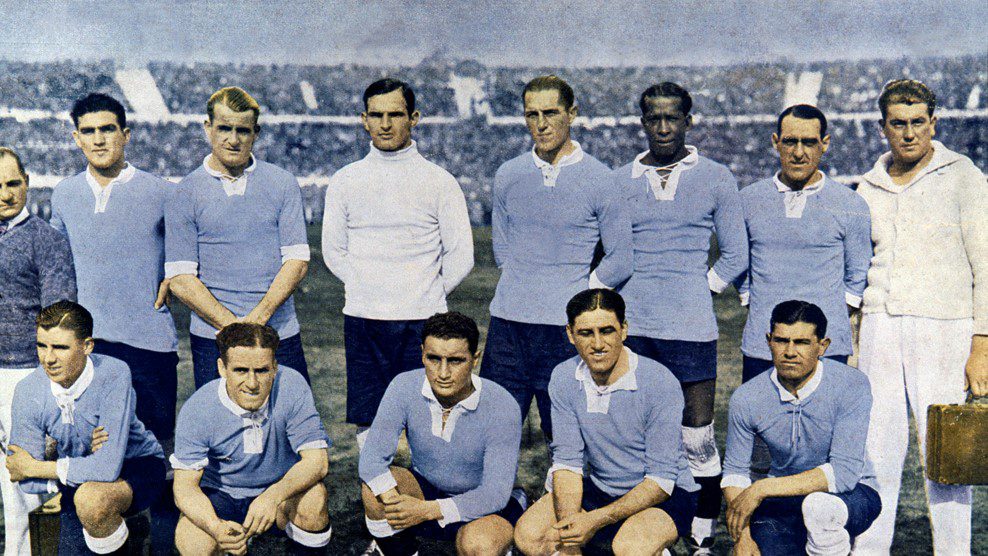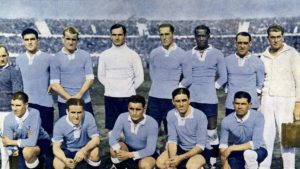
The World Cup in A Uniform
The Phenomenon Itself
A brave new world just about ready to begin a new form of trying. An attempt at reeling in the countries, bringing them together in more ways than through the horrid events such as those in World War 1 or the competitive yet exciting Olympic Games that began just a few years earlier. The initial World Cup began in 1930 in Uruguay’s capital, Montevideo. Although its complexity did not develop until later years it was the start of what some soccer fans may call “a new world”, a “lifestyle”. Humans have always interacted with the environment, scavenged, what they believed was their road to survival, or taken risks when they did not quite know what else to resort to. Before globalization, exploration, expedition and the assimilation of people to a single cultural group, cultures were so distinct that they continued to build on what they had, for themselves. It wasn’t too much of a concern that this country had too few resources and another’s was corrupt, it was about human interaction with their environment, their own ground. From the famous spices of India to the abundant crops of the Americas, humans have simply interacted with their environment. The vessel or glass of our existence is never fulfilled because it will always be half empty.
“Football” Comes to Play
So, as of 2,000 years ago in the countries we know of as China, Greece and Rome humans kicked around a cluster of animal hides. This activity, that may sound strange at first, became more and more popular, but remained unique. The British made this outdoor activity to become spoken as “football”, a game that can be meditative, competitive, and one with dreams and lives at stake.
Participants in The Game
Despite the amount of children who played this in the mud or individuals who knew it as their family’s spare-time entertaining hobby, the game was not entirely appreciated until the announcement of the first World Cup in history, which as mentioned previously took place in Montevideo Uruguay in 1930. This Cup was yet to be adapted. But for the year of 1930, its innocence was simply the 13 countries, without series or groups, just straight elimination rounds. Europeans complained about the unjust selection process of the location of the first World Cup, in other words the fact that it took place in South America rather than in Europe, driving out all European countries of interest to participate. However, after some convincing led by Jules Rimet, the founder of the soccer World Cup, France, Belgium, Yugoslavia, and Romania joined. Together the countries to participate in the opening of the football games, were Uruguay, Brazil, Argentina, Paraguay, Chile, Peru, Bolivia, France, Belgium, Yugoslavia, Romania, US, and Mexico.
Uniform Alterations
I am sure many of the much more dedicated soccer fans than myself have almost completely memorized all the players, the years, the winners of each world cup, but I am offering my insight on how the kits or soccer uniforms have changed over the years alongside the fashion that people experienced first hand on the street. Using the Argentinian uniforms as an example, that parallels with the other team uniform adaptations, the uniform began with its signature light blue and white vertical stripes, a white small collar, a lace tie just beneath the convergence of the collar tips, mid length sleeves and the shorts around 6 inches above the knee, similar to how they are today but with no logo. In the year 1974, a key noticeable alteration to the uniform was the numbering of the shorts as identification of the players, and in 1990 the face of the adidas brand began appearing on the shorts as well, marking the introduction of branding and how the World Cup has become a sea of advertising opportunities. The final major change was in 1994 when the uniforms also had the addition of player numbers on the shirts. As one observes the Argentinian uniforms over the years of World Cup seasons, it is apparent that the designer developed different assortments of the three signature stripes associated with the symbolic Argentinian colors. This year, in 2018, the uniform of the Argentinian players is characterized by a white based shirt with three faint stripes, which are somewhat ombre. Additionally the evolution of design and color play, includes the introduction of the country’s national symbol, the adidas logo, and the player number centered in the front.
1930s
As a soccer fan myself and one who looks forward to watching my team excel every four years I have taken a passion on doing background checks on all of my favorite players. In the 1930s when the amazing historical soccer phenomenon of the World Cup began, most of us probably immediately thought of the movies we watch or our parents made us watch of Bette Davis or Gary Cooper, we envision the slim, high waisted suits, the long extended collars, the casual addition of a cap or loafers. It is what we aren’t familiar with that we know the least about. But the passion and anticipation that led both France and Croatia eagerly to watch and celebrate the Finale this year is one built on pride and development of members of that country.



